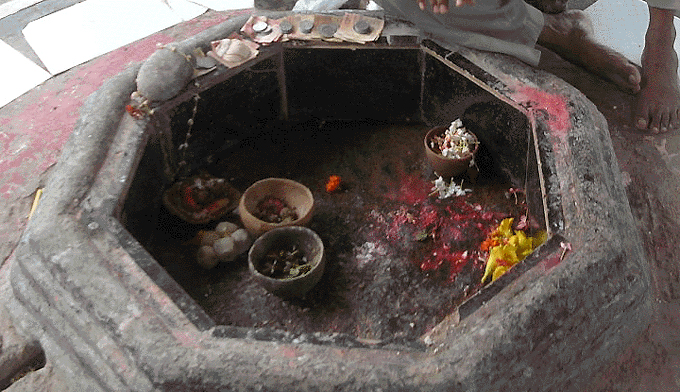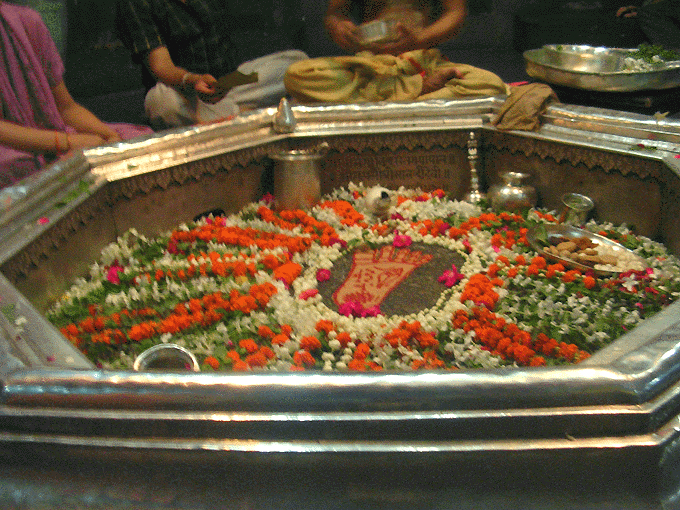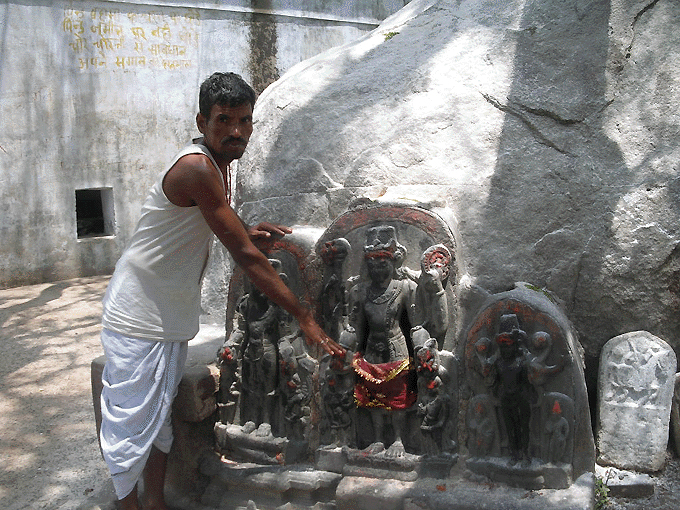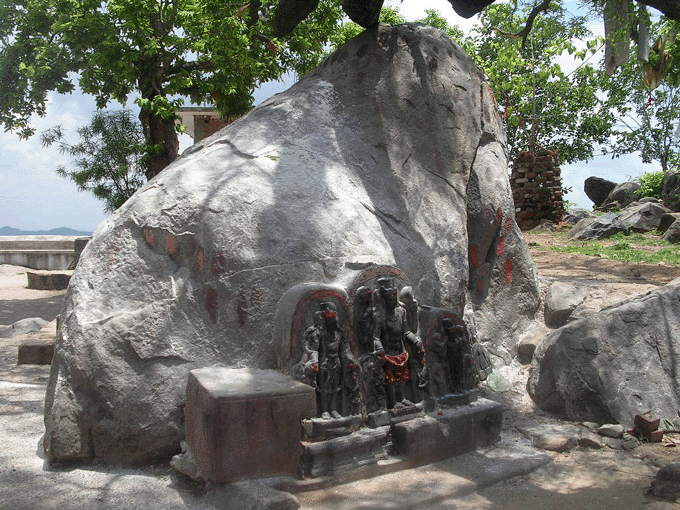
|
|
|
|
Pret-shila Hill, situated to the northwest of Gaya, is a sacred place for Vaisnavas and Saivites, who come on pilgrimage to offer Gaya is mentioned in the great epics, Ramayana and Mahabharata. In the Mahabharata, the place is identified as Gayapuri. Gaya's name is not associated with Buddhism, which manifested here relatively recently, in the whole of Gaya's ancient history. It was named for the famous pastime wherein Lord Visnu came to slay the demon Gayasura. This pastime is presented in detail in the Gaya Mahatmya, and is elaborated upon below. Briefly, the demon took advantage of a boon given by Lord Brahma, he became puffed up and behaved very sinfully, and Visnu came with His mace to put an end to the suffering the demon was causing the devotees. The entire region of Gaya resides in the footprint impression left by Lord Visnu, who held the demon down beneath His foot. In this way, the Panchkosi Gaya Kshetra was created.
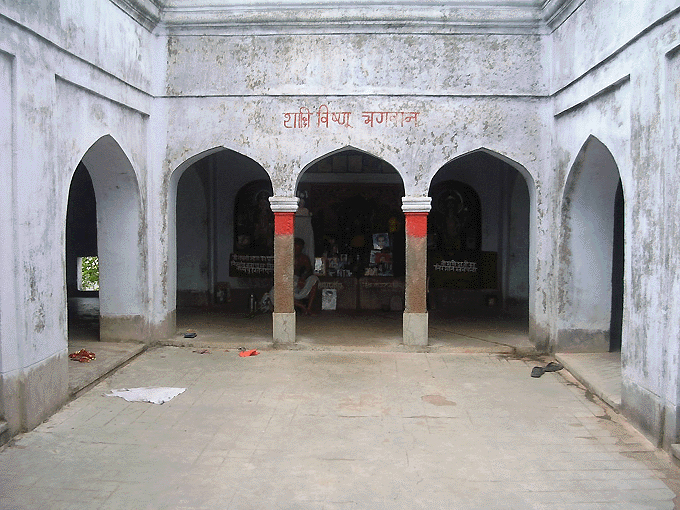
Pret-shila Temple The demon, who was created by Lord Brahma, has his head in the north area, from Bodhgaya in the south to Pret-shila in the north. After the asura's death, the devotees flocked to Gaya to perform shraddha, or pinddaan sacrifices on top of his body, to absolve their ancestors of sin. Even to this day, many pilgrims come here for that purpose. They climb the Pret-shila Hill, at the summit of which is the temple of Pretaraja, or Yamaraja. Lord Yama is said to have built this temple in order to pacify the preta (ghost) said to haunt it, the ghost presumably being Gayasura.
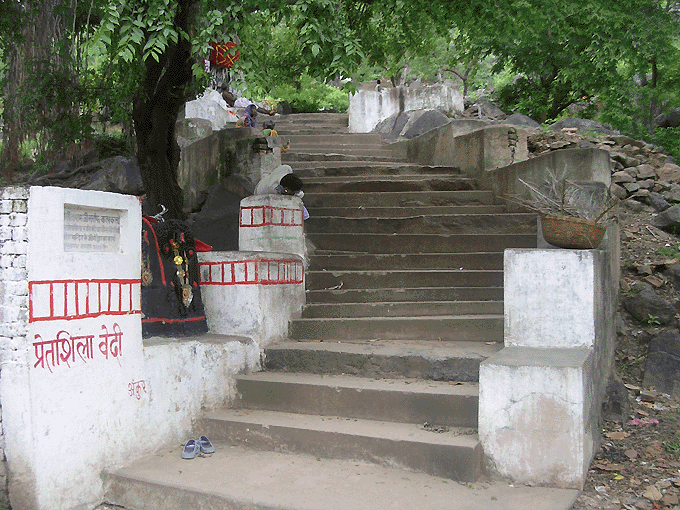
Steps ascending Pret-shila Hill Pret-shila Hill Temple has been renovated many times over the years. Rani Ahilybai of Indore funded one of the renovations, and the temple is also known as Ahilyabai Temple, in her honor. An inscription in the temple dated 1744 A.D. records the construction of the long flight of steps leading up to the temple, which were built at the expense of Sri Manmohan Datt of Calcutta.
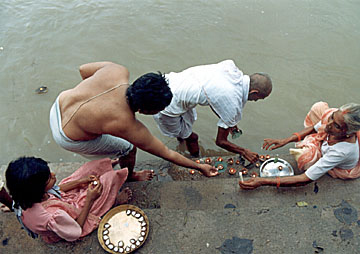
Brahma Kund Deities of Visnu, Mahismardini Durga, Surya and other Buddhist divinities have been placed around the hill. At the foot of the hill is the Ram Kund Tank, in which Lord Rama himself took bath before offering pinda to His ancestors. There is also a Brahma Kund at the bottom of Pret-shila Hill, where pilgrims take bath before offering balls of flour and rice, called pinda, with prayers for their departed.
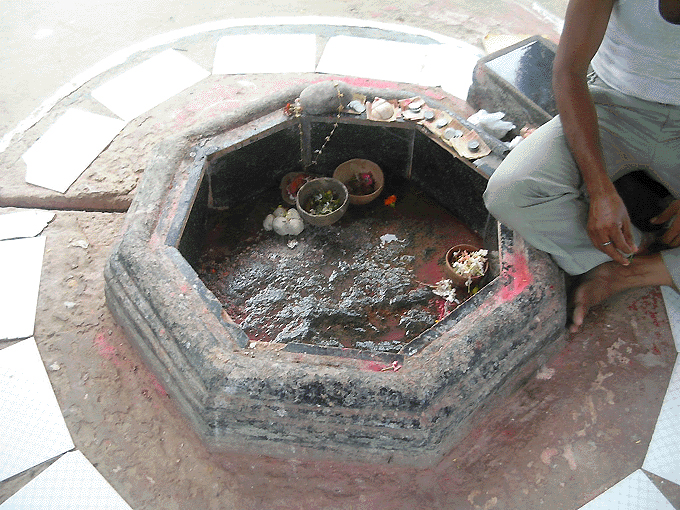
Lord Brahma'S Footprint About 10 km from Pret-shila Hill is the Ram-shila Hill. In fact there are six important hill stations around Gaya: Pret-shila, Ram-shila, Brahmayoni (Brahmajuni), Gurpa, Pragbodhi, and Gridhakuta Hills. The Ram-shila Hill sits on the west bank of the subterranean River Phalgu (Falgu). The water of this very unusual river cannot be seen from the surface, as it always remains beneath a thick layer of silt and sand. Devotees who go to Gaya dig holes in the river to take out its water. Lord Ramacandra came to Gaya to offer Ram-shila Hill is home to the Visnupada Temple, also built by Rani Ahilybai of Indore. This is where the famous footprint shrine of Visnu is found. The temple has a 30 meter high silver-plated peak which rests on 8 rows of ornate pillars. Behind the silver folding doors of the sanctum is the Lord's footprint, encased in solid silver. About a kilometer southwest of the Visnupada Temple is a long flight of steps, 1,000 in number, which ascend the Brahmayoni Hill. At the summit is the temple of Pataleswar Shiva, Lord of the Underground. This long flight of steps was built by Rao Bhau Saheb during the reign of Jayaji Rao Scindia of Gwalior, around 1843 A.D.
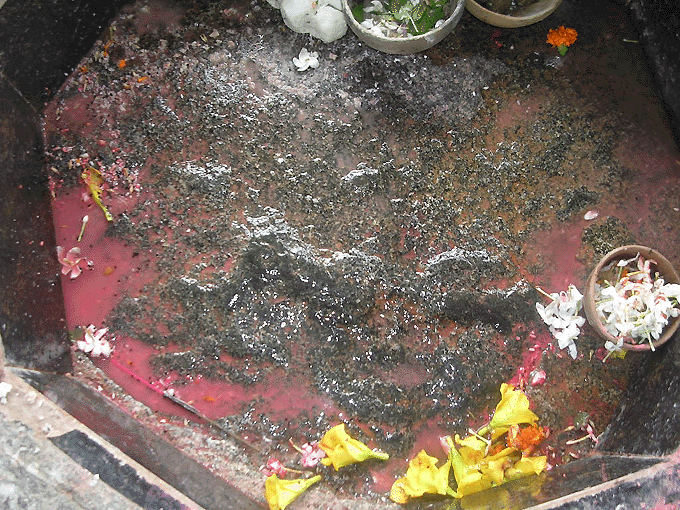
Lord Brahma'S Footprint Brahmayoni Hill is the highest hill in Gaya, named for the natural fissure at its top which is believed to represent the female energy of Lord Brahma. In the small temple there is a five-headed female deity named Brahmayoni, who is the embodiment of Lord Brahma's feminine creative nature. The Brahmayoni Temple was built by a Maratha chief, Balaji Pandit. Devotees throng here during the Pitripaksha Mela to say prayers for their ancestors.
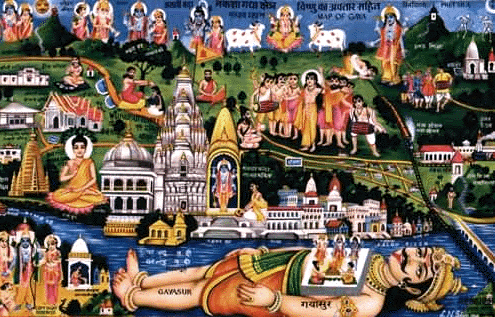
Demon Gayasura at Gaya Kshetra
There are several versions of the story of Gayasura. One can be found in the 'Demons' section of this website. Another tells the story of Gayasur as a member of the demon dynasty. By performing strict austerities to please Lord Brahma, he got Brahma's darshan and asked him for a boon. Like Hiranyakasipu, Gayasur asked to be given immortality. Brahma did grant a boom enabling him to go freely about his business, and although he committed so many atrocities, no one could slay the demon. Defeating all the kings, Gayasura eventually took possession of the earth. All the saintly people were forced to go into hiding, and this was the state of affairs for one entire kalpa. Satya yuga, Treta yuga, Dwarpa yuga and Kali yuga all passed away, and still Gayasura remained in power. One day the demon was returning from Dwarikapuri, going to Darukavan. He saw a mahatma sitting beneath a tree, singing praises to God. The demon requested that the sage let him drink his blood, because he was thirsty. Recognizing the demon, the sage agreed, afraid for his life, but clever enough to ask if the demon would answer one question before killing him. Gayasura agreed. The sage asked how it was that so many living entities were working to get salvation, performing so many austerities, offering yajnas, etc., while the demon was able to get away with committing so many sins. As the demon thought about his answer, he pondered the question, thinking about all his crimes, and he shivered in fear. He began to beg the mahatma to tell him how deliverance for someone as evil as himself was possible. The sage told him that only Lord Narayana could save him, and that the Lord could be bound at Badri Dhama. The demon set out for Badri at once, but arrived to find the Lord's lotus seat empty. Walking away, he met Narayana on the path. The Lord grabbed the demon by the hair, and the place where this happened is today known as Gaya. The demon refused to surrender, even after being caught, so the Lord attacked him with His mace. Gayasur was broken into pieces. The spot where the first piece fell is today known by the name Brahma-kapal (Badrinath), because the demon had been created by Brahma, and was now being destroyed. Narayana struck again, and a second piece of the asura fell, at Haridwar. That piece is known as the Narayana-shila. A third piece fell in Gaya, where it is worshipped as the footprint of Visnu. Today, those who visit all three of these holy places on pitrakarma are said to be able to deliver their forefathers. There is a group of hereditary brahmans who live at Gaya, known as the Gayawal. Their clan claims to have been specially created by Lord Brahma to assist him in the great fire sacrifice that was performed after the demon Gayasura was put down. Brahma is said to have created fourteen clans, or gotras, specifically to assist him in this great yagna. All this is explained in the Vayu Purana, which provides a detailed narration of the Gayasura pastime. The Vayu Purana prescribes the respect due to be given to Gayawal. All 120 families of the Gayawal clan live in the southern portion of Gaya, on the banks of the sacred river Phalgu, and around the Visnu temple. Their lands are fortified on all sides, with gates in three of the cardinal directions. A subset of the Gayawal known as the Dhami are responsible for officiating at the shraddha rituals performed at five sacred spots in Gaya: Preta-shila, Ram-shila, Kak Bali, Brahma Kunda, and Ram Kund. They are considered to be an ancient non-Brahminical priestly order.
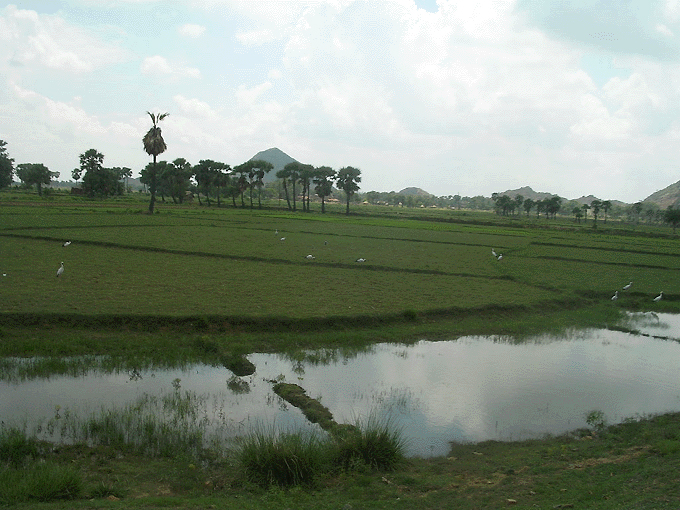
The road to Pret-shila Hill
| |
